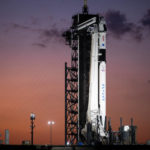Photo caption: The six women astronauts selected by NASA in 1978, Shannon M. Lucid, left, M. Rhea Seddon, Kathryn D. Sullivan, Judith A. Resnik, Anna L. Fisher, and Sally K. Ride, pose with an Apollo-era space suit. Courtesy: NASA
While today marks International Women’s Day, this month is also Women’s History Month 2023: Celebrating Women Astronauts, and NASA is celebrating by releasing a history of the 72 women that have now flown to space.
NASA said: “Of these 72 women, 44 have worked on the International Space Station as long-duration expedition crewmembers, as visitors on space shuttle assembly flights, or as space flight participants on short-duration missions. These women, from all over the world, made significant accomplishments as well as the pioneering women who preceded them into space. Many other women contributed to the assembly of the station and the research conducted aboard on a daily basis, including those on the ground who served as centre directors, managers, flight directors, and in many other roles to pursue the exploration of space. Their achievements will contribute to NASA’s efforts to land the first woman and the first person of colour on the Moon and possibly send the first crews to Mars in the coming decades.”
NASA mentions many women in the story of women in space – but it all started with Valentina V. Tereshkova.
NASA said: “The era of women in space began on June 16, 1963, when Soviet cosmonaut Valentina V. Tereshkova launched aboard the Vostok 6 spacecraft. Chosen from a group of five women selected for training, Tereshkova completed a three-day mission and entered the history books as the first woman to orbit the Earth. Nearly 20 years passed before another woman flew in space. In January 1978, NASA announced the selection of 35 new astronauts including six women for the space shuttle programme. In response, the Soviet Union secretly selected a group of nine women cosmonauts in 1980. On Aug. 19, 1982, one of these women, Svetlana Y. Savitskaya, launched with her two crewmates aboard Soyuz T-7 for a week-long mission. The next day, they joined the two long-duration resident crewmembers aboard Salyut 7, marking the first time a space station hosted a mixed-gender crew. Ten months later, on June 18, 1983, astronaut Sally K. Ride made history as the first American woman in space, spending seven days aboard space shuttle Challenger during the STS-7 mission.”
First Brit in space
Another female astronaut who has inspired many women astronauts is Helen P. Sharman – the first British person to go to space.
NASA said: “Helen has the distinction as not only the first person from the United Kingdom in space but also the first woman to visit the Russian space station Mir. During her eight-day privately funded Juno mission in May 1991, Sharman conducted a series of life sciences experiments and talked to British schoolchildren. The next month marked the first time that a space crew included three women – NASA astronauts M. Rhea Seddon, Tamara E. Jernigan, and Millie E. Hughes-Fulford – during the STS-40 Spacelab Life Sciences 1 mission.”
Some of the other female space inspirers include Russian cosmonaut Elena V. Kondakova – the first woman to complete a long-duration mission, NASA astronaut Pamela A. Melroy served as the first female pilot on a shuttle flight to the space station, the STS-92 mission in October 2000 that added the Z1 truss, control moment gyros, and a Pressurised Mating Adapter to the growing station, and NASA astronaut Peggy A. Whitson who holds the distinction as the first female commander of the space station during Expedition 16 in 2007, her second long-duration mission to the orbiting lab.

